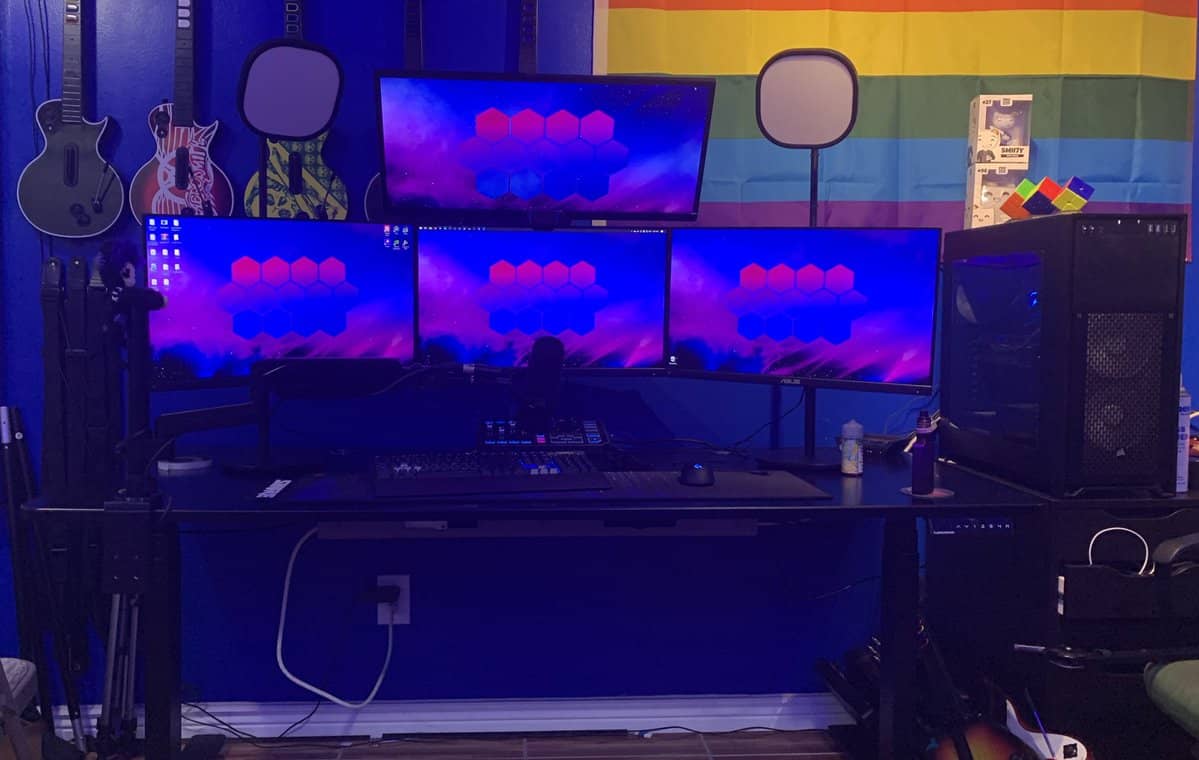If you haven’t tried building a gaming PC in your life, it’s normal to have a lot of hesitations. You might even feel that you will break something in the process. Worry not, it’s all on your head. And you’d be surprised at how easy it is to build a PC for a newbie like you.
I’ll be listing the steps in a detailed fashion. But let;s take a look at some pre-prep first.
Buying the parts
it‘s easy to get overwhelmed with all the parts that you need. So you have to determine a budget and work your way around it. But try to also be a bit more flexible. You might not want to spend more than 1500 on the concept that you have in mind. But if you just need to add a bit of money, try to give it still a go.
And always buy parts from reputable stores. And as much as possible, buy from known or reputable brands.
You might save a bit if you buy from an unknown manufacturer, but there’s a lot of risks there. Customer service is not yet verified. So if anything goes wrong with your purchase, you might not have someone to help you with returns or exchanges.
Alternatively, you can ask your techie friends for recommendations. They can also give you the best options and show you the best places to buy these.
Gather all the components that you need
Before we start building you have to ensure that you have all the parts on hand. Here are the basic components that you’ll need:
- Processor or CPU
- Motherboard
- Memory or rams sticks
- Power source
- PC
Also, get your hands on a USB of at least 8G. You’ll be using this to set up your Operating System later.
Have the necessary tools on hand.
You’ll also need your handy screwdriver. It’s better to have multiple screwdrivers in hand, though most PC builds require a Philips # 2. But it’s nice to have several bits of screwdrivers that can accommodate different types of screws and nuts just in case you need them.
Plastic cups or any containers to store screws and nuts are also handy. It’s frustrating to lose screws and nuts. And it’s very easy to lose one since they tend to roll over the desk.
Lay out all the items you need on a wooden desk
Wooden desks are ideal for such a setup. But if you don’t have one, metal desks are also okay, you have to ensure that it’s properly grounded first. And you can also use an anti-static mat and wristband just to be 100 percent sure.
And remember to place all your components away from carpets. You want to prevent static electricity so you have to stay clear from carpets and even your pet’s fur.
Installation proper
- Unbox your motherboard and remove it from the plastic. Gently place it on top of the box where it came from. You’ll also be getting the iO shield and the SATA cables from the box. Set them aside too.
- Take out the CPU and the cooler from the box. Avoid touching the bottom part of the cooler as it has themopaste on it. Then lay it on the table with the themopaste part facing upward. Gently pull the CPU from the container and ensure that you’re grabbing it by the edges.
- Flip the CPU and you’ll find a triangle at one of the corners. We’ll connect this side of the CPU socket cover on the motherboard. To do that, press the lever and push it up from inside. Lift it up a bit until it opens.
Gently lay the CPU on the socket side, making sure to hold the CPU just by the edges. Also, ensure that the triangle on the CPU is aligned with the triangle located inside the socket. Remember to not put any force on the CPU and just lay it down gently on the socket side.
- Gently close the cover. And you’ll find that the back case automatically pops out once the CPU is locked in place.
Now we will install the cooler. Align the four legs on the cooler to the four holes on the motherboard. Also, check the cables if it’s long enough to reach the header of the motherboard. Otherwise, you can rotate the cooler to extend the cables a bit. Then gently press down on the leg, one at a time to lock the color to the motherboard.
- Grab the cooler gently to ensure that it’s safely secured to the motherboard. Now we’re going to hook up the cooling fan to the board. Grab the 4 pin cable and attach it to the CPU fan header on the motherboard.
- Now we’ll head on to the installation of the RAM sticks. You’ll see on the motherboard that it has labels that shows you what RAM slots to occupy first.
Grab your RAM sticks and hover it over the slots. We have to ensure that the gap on the sticks is aligned with the gap on the slot. If not, just turn it over and it should be aligned.
Lower the sticks to the slots and gently push down on the center of the RAM until it snaps in place.
- Get your PC and unscrew the sides to take out the side panels. You’ll find a bag of screws inside. And this is what we’ll use to install the hardware.
First, let’s install the IO shield. Remove it from the plastic and hold it in such a way that the 6 circles are at the bottom. Slide it up in the back of the case from the inside. Apply a bit of pressure to the four sides to secure the Ios shield to the PC. It should snap in place, but do not put any pressure on the center part, otherwise, it can break.
- Place the motherboard on the case and see where each hole aligns. Once you have all the holes aligned, start tightening the screws on all sides. Make sure it’s snug but not too tight.
- It’s time to secure the rear fan to the motherboard. So grab the cables from the rear fan and connect it to the system fan header on the motherboard. If you can’t find it, it’s sitting right next to the RAM sticks.
- Unbox the power supply. Reposition the CPU so that the fan faces down. Place the power supply on the back of the casing. The 4 screw holes should align with the cutouts on the chassis. Once aligned, you can start screwing them in.
- Let’s hook up the hard drive. You typically will find a base or a metal tray inside, this will hold the hard drive. Once you find it, align the holes of the tray with the screw holes of the hard drive. Then insert the hard drive (with the circuit side facing down) into the tray. You can slide the tray until the hard drive snaps in place.
Alternatively, you can use an SSD. you can install it near the optical drive area or you can hook it up on the back of the chassis on its side. Align the holes and screw until it fits snugly.
- Up next is hooking up the storage drive. And we’ll need the SATA cables that we have set aside earlier. Also, pull out the data cable that’s in the power supply box. Connect the SATA cables into the smaller slot of the hard drive. Then connect the other end to the motherboard. (Quick tip: don’t use SATA 1 slot if you are building an M.2SSD)
Connect the data cable to the hard drive, and it’s right beside the SATA cable.
- Now, start to unscrew the back panel and remove the first and second-tier covers. This is where we’ll mount the GPU. Get your GPU and align it to the top slot of the motherboard. Once it’s aligned, you should hear a snap, so gently apply a bit of pressure to secure it. It’s ideal to mount the GPU on the first two slots for maximum performance.
Screw the bracket on the back of the chassis, you should also be holding the GPU at the same time to ensure it won’t sag.
- Connecting all the cables.
- GPU
Get the GPU cable and grab the part with the 6 ins (labeled as PCIe). Connect this port to the GPU SOCKET
- Power source
Get the cable included in the power supply box. Connect the 24 pin cable to the 24 pin socket on the motherboard
- CPU
Connect the cables labeled CPU to the CPU socket on the motherboard. It’s right above the cooler.
- USB
If you’re using a USB, connect the blue USB cable to the motherboard. It’s located under the 24 pin slot. But before connecting the USB cable, make sure that it’s facing in the correct direction. Otherwise, it can damage the pins.
- Audio
This should be connected to the far left side of the motherboard (Jaudio 1). We can also plug in the extra USB cable to power the other ports. Connect it to the slots labeled JUSB2 or JUSB1 on the motherboard.
- Fans
Let’s hook up the two fans to the front of the case. Grab the two cables from the fans and connect them to the mollusk connector coming out from the power supply unit
- Powering the front panel
Connect the cables needed to power the front panel of the case or chassis. It consists of 4 connections and best done as per the arrangement below.
- RESET SW to pin number 3 & number 4
- POWER SWITCH right on top of the reset switch
- HDD LED (words facing down) to the second row
- POWERLED + and – to the second pin
Now that all the cables are connected, it’s time to manage them. You can use the extra space inside the chassis to hide the extra cables. In addition, velcros and tags can help you keep the setup clean.
- Screw back the side panels.
- Now, all that’s left for you to do is to set up your operating systems! And you’ll be using your 8G USB for this one.
Conclusion
Building your own gaming PC might take some time, especially for newbies. And our step by step guide will help you through it.

